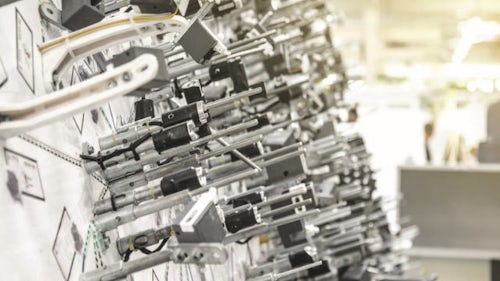Utilize KSK production solutions to tackle complexity and increase profitability
The automotive industry faces multiple challenges due to the demand for advanced electronic features, advanced driver assistance systems (ADAS), autonomous driving, and electrification. These megatrends create the need for highly sophisticated automotive electric and electronic (E/E) systems, emphasizing the importance of wire harness manufacturing. A significant challenge for automotive original equipment manufacturers (OEMs) and harness manufacturers is managing complex wire harnesses from design and manufacturing to delivery.
In this white paper, discover one of the most desired solutions to this pressing issue: the Kundenspezifischer Kabelsatz (KSK) concept. Download it now to learn more.
Use KSK manufacturing to manage complex wire harnesses
New and more advanced vehicle features are increasing the complexity of wiring systems, containing an average of 10,000 unique part numbers. Today's manufacturers must accommodate the millions of possible vehicle configuration combinations while meeting very tight timelines, following precise quality requirements, and minimizing the wire harness' cost and weight. The most desired solution is the KSK concept, which originates from Germany and translates to customer specific wire harness. While this concept is already industry proven, traditional KSK data assimilation approaches could soon become irrelevant as harness manufacturers undergo digital transformation.
Data-driven, efficient operation of the KSK production system
KSK’s complexity requires strong communication, data coherency, and a robust data flow between disciplines from the RFQ stages to production. Harness manufacturers must seek to eliminate silos between all significant business disciplines for a successful KSK manufacturing model/system. Manufacturers can optimize harness production for modularization, design rule check, creating modules, and value analysis and value engineering activities by using advanced harness engineering software. These production modules support efficient manufacturing without limiting flexibility and intensely focus on change management. And software for manufacturing can support production modules, harness analysis, bill-of-process (BOP), formboard preparation, and work instructions for assembly operators.
Support any number of wiring harness variants
KSK methods can adapt to fit the specific needs and conditions of the vehicle program that it will support. Using integrated software, engineers can create a digital thread from vehicle definition to manufacturing planning and execution. They can pull complete and up-to-date information on required assembly tasks to allocate resources and plan production. Any changes they make will automatically update tasks with the correct workstation assignments. Using the updated information, engineers can generate workstation-specific instructions for the manufacturing floor. Although complex, KSK flexibility and organized planning enable production methods to support any number of harness variants.
Discover how KSK manufacturing enables harness manufacturers to handle complexity with high efficiency and adaptability to follow rapid timelines while prioritizing quality requirements and minimizing excess costs — Register now to download the white paper.
